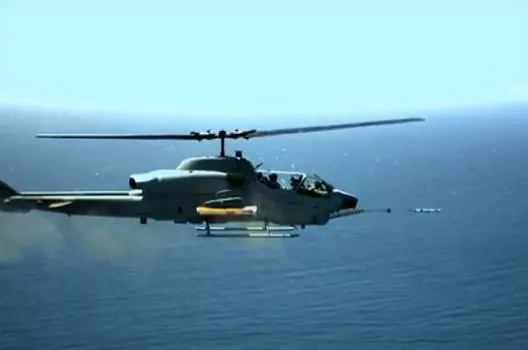At the 63rd annual Naval Helicopter Association (NHA) Symposium in San Diego last week the Office of Naval Research (ONR) unveiled a new weapons technology designed to give helicopters, such as the MH-60 and the AH-1 Cobra, the ability to combat the threat of a small boat swarm. The Low-Cost Imaging Terminal Seeker (LCITS) system equips existing unguided Hydra-70, 2.75-inch rockets with a low-cost guidance capability that allows pilots to essentially "fire-and-forget," thereby allowing them to engage multiple, fast attack seaborne targets in a shorter period.
Unlike laser-designated weapons, the LCITS system provides pilots with the ability to respond faster to threats by relieving them of the responsibility of guiding the weapon to the target while it is in flight. The system comprises three main components; the algorithms that calculate targeting and transfer alignment data; a digital smart launcher that transmits targeting data to the weapon; and the LCITS weapon itself.
Once the target is designated by the helicopter's forward-looking infrared (FLIR) sensor, targeting data including position, size, velocity and contrast are passed through the digital smart launcher to the guided rocket. The rocket then calculates an inertial guidance point and flies to where it will acquire the target with its imaging infrared seeker. This is not a hot-spot detector but a low-cost focal plane array that feeds an image to on-board algorithms that separate the target from the background. The infrared seeker then guides the rocket to hone in on the center of the target.

The ONR says the LCITS system will potentially reduce the target engagement timeline to less than 15 seconds, thereby allowing pilots to increase the number of targets they can engage within a short period of time. This will give naval forces a cost effective tactical advantage over small swarming boats and allow them to be engaged before they can get close to their target.
"The LCITs program is considered 'low cost' because it is an augmentation or upgrade to a pre-existing 2.75-inch rocket system," said Michael Deitchman, director of ONR's Naval Air Warfare and Weapons Department. "Instead of relying on costly parts, sensors and guidance systems, it relies on the aircraft systems to provide the targeting information."
The system is the result of a collaborative effort between the ONR and partners including South Korea, DARPA, the Office of the Secretary of Defense, and the Navy International Program Office.
A final demonstration of the LCITS technology took place on May 1, 2010, when an LCITS rocket fired from an AH-1 Cobra helicopter scored a direct hit on a moving maritime target that represented a small boat threat. The technology is now undergoing further testing as part of the Medusa Joint Capability Technology Demonstration (JCTD), with the goal of integrating the rocket onto the MH-60 aircraft platform.





